Five Underrated Fish
Fish are fickle and so are fishermen. Everyone has seen a sportfish turn its nose at a perfectly good bait. And, everyone knows an angler who turns his nose at targeting a perfectly good sportfish. While tarpon, white marlin, striped bass and other high-profile species get all the love, lowly targets like false albacore, ribbonfish, sheepshead and bluefish don’t get the respect they deserve.
In some cases, these lowly species gain attention during the offseason. On other accounts, the unappreciated species is a plan B after a high-profile species is depleted or strictly regulated. But a small group of anglers have elevated these unloved species to a higher level. They’ve discovered there’s a lot to love about these underrated fish.
False Albacore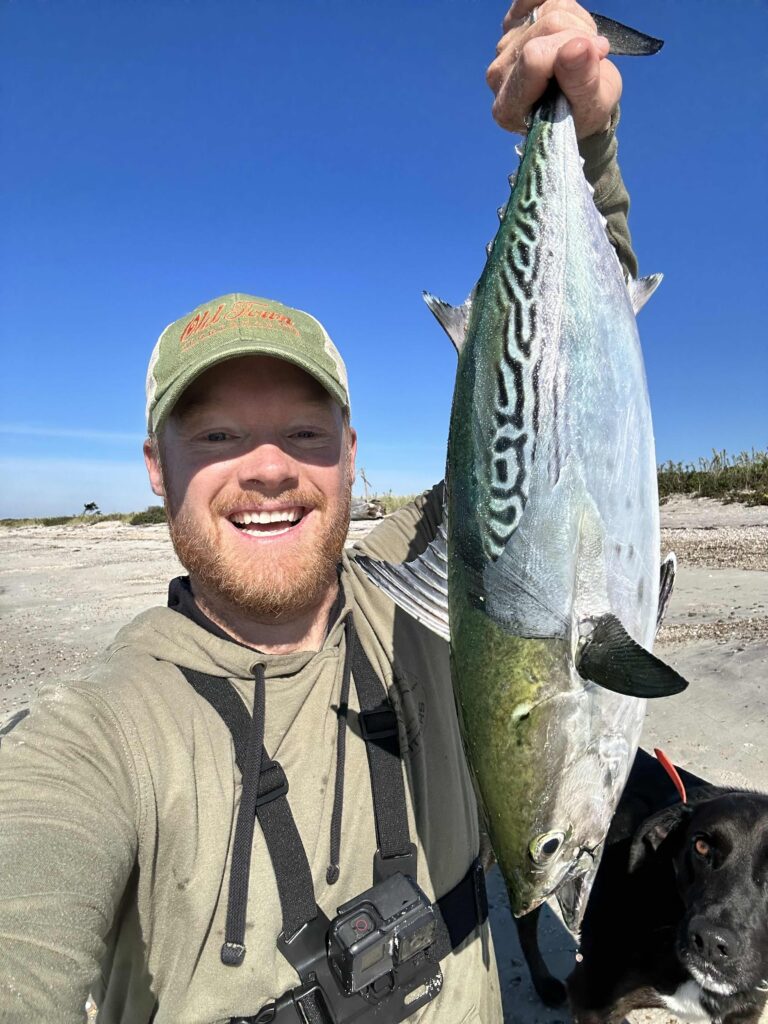 False albacore put on impressive runs, and can dump a spool pretty quickly.
Courtesy Matt Stone
False albacore put on impressive runs, and can dump a spool pretty quickly.
Courtesy Matt Stone
“Nothing ruins a mahi spread faster than a pack of albacore,” says Matt Stone of Black Hall Outfitters in Westbrook, Connecticut. While offshore anglers detest false albacore, inshore anglers chase the little tuna with a passion. “After my first albacore on light tackle, I was obsessed,” Stone admits. In hotspots like New England and the Carolina Outer Banks, a culture of false albacore aficionados descend on the area during the season. That’s because these speedsters offer a drag-screaming battle unmatched in shallow water.
For Stone, albacore fishing is a social event. “Most of the year I avoid people, but during albacore season I rely on a network of friends to track the fish’s migration.” On the water, albacore present another challenge. Chasing albacore requires covering miles of water looking for birds swirling and breaking fish. Once he catches up with a school of Alberts, Stone makes a long cast with a small lure to avoid spooking the fish. “Albacore are notoriously fickle and sharp-sighted, requiring impossibly light leader.” He cycles through a half dozen lures until he dials in the picky fish’s appetite. The payoff is one of the best inshore battles as the little tuna bend the rod and smoke the drag. “If I catch one albacore the whole day is worth it.”
Ribbonfish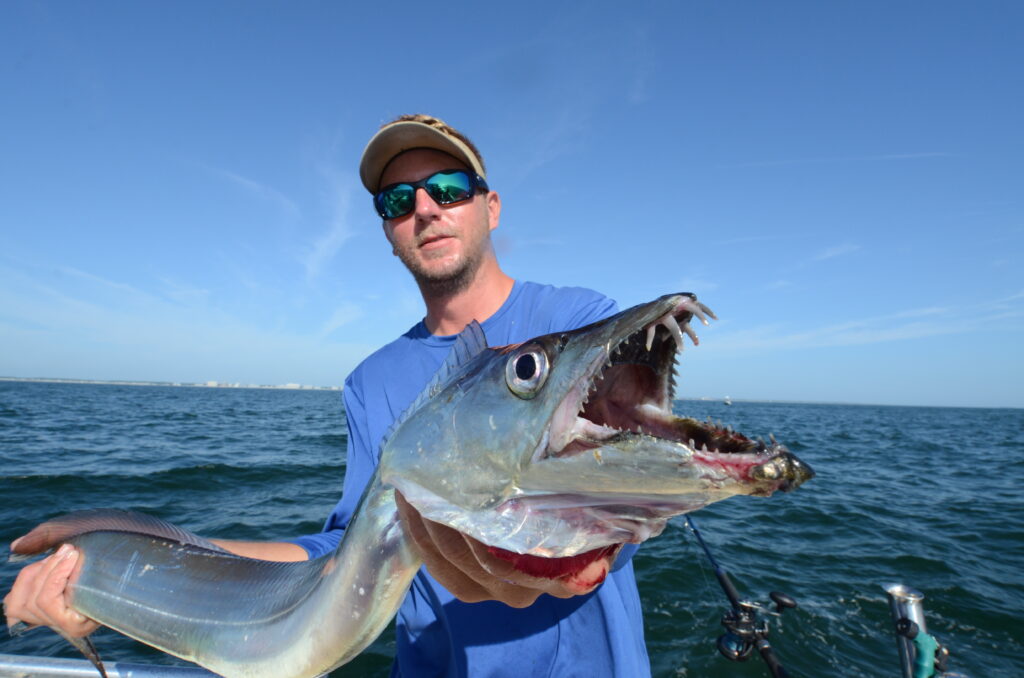 They are definitely not the prettiest fish in the sea, but ribbonfish filets should be welcome on your dinner plate.
Courtesy Ric Burnley
They are definitely not the prettiest fish in the sea, but ribbonfish filets should be welcome on your dinner plate.
Courtesy Ric Burnley
Ribbonfish win the award for strangest looking sportfish. Shaped like a sword blade, measuring up to 5 feet long but only a couple inches wide, the shiny silver fish are also called cutlass fish. Ribbonfish have long, thin dagger-like teeth and they use their sharp, pointed tail to slash like a knife. While the ribbonfish’s appearance scares away some anglers, Capt. Stan Gold of Blind Date Charters in Virginia Beach embraces the plentiful and aggressive predators. “I first caught ribbonfish while trolling for Spanish mackerel,” Gold recalls. Initially, the sharp-toothed ribbons destroyed Gold’s mackerel spread. After some research and adjustments to his tactics, the captain learned how to catch the strange sea monsters with light tackle.
Gold uses a 6-foot medium-action jigging rod and compact conventional reel to work a small bucktail or vertical jig baited with a strip of cut bait. “Ribbonfish hit like a freight train and use the long body to put up a good fight,” Gold says. When ribbonfish are schooled up and feeding, the action is fast and furious. On one of his best runs, Gold and another angler caught 1,400 ribbonfish in two days. To measure a trophy ribbonfish, Gold uses his fingers. “The average fish is three to four fingers wide, when they get to five fingers that’s a trophy.” Gold’s longest ribbonfish was over 6 feet long and seven fingers wide! While local anglers turn away from ribbonfish in favor of Spanish mackerel, cobia and redfish, Gold points out another important advantage. “Ribbonfish are easier to catch.” Did we mention they taste pretty good, too?
Squid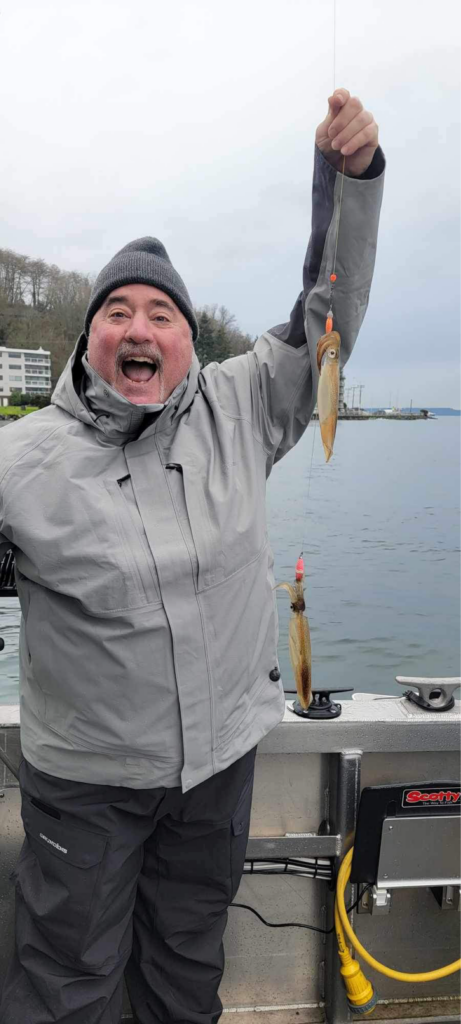 Squid offer a tasty, and fun, target for anglers in both coasts.
Courtesy Capt. Paul Kim
Squid offer a tasty, and fun, target for anglers in both coasts.
Courtesy Capt. Paul Kim
There is a long history of shore-based squid fishing in Puget Sound, but Capt. Paul Kim of Fish PNW Guide Service says there is a growing number of recreational anglers targeting them from boats. “I started taking my kids squid fishing on the piers and docks downtown,” Kim says. However, unsafe fishing conditions and a crowd of salty characters prompted Kim to try squid fishing from his boat. “The first time I took the family squid fishing we had a great time,” he recalls. In recent years, squid fishing has become more popular. Kim explains, “There are fewer salmon and stricter regulations, so people are turning to squid fishing.”
For the past three years, Kim has been a featured speaker at the local boat show. “The first year we posted a YouTube video about catching and cooking squid and it went viral.” The most recent seminar attracted a full house. When the squid bite is on, Kim says the action is fast and furious, with anglers catching the tasty treats on specialized jigs almost as fast as they can get them back in the water. The squid are 12 to 15 inches (market size, Kim says) and they are feisty. “Fighting several squid while they dart and pull is too much fun,” Kim points out. He says they are underestimated, but the lightning fast predators are actually intelligent hunters. And then there is the ink. Kim laughs, “People say I don’t want to get ink all over my boat.” The reward is one of the most energy dense proteins that tastes delicious in a variety of preparations. As opposed to uber-competitive salmon fishing, Kim says squid fishing is friendlier. “When multiple boats are anchored in one area and the anglers are helping each other get on the bite, everyone is having fun.”
Sheepshead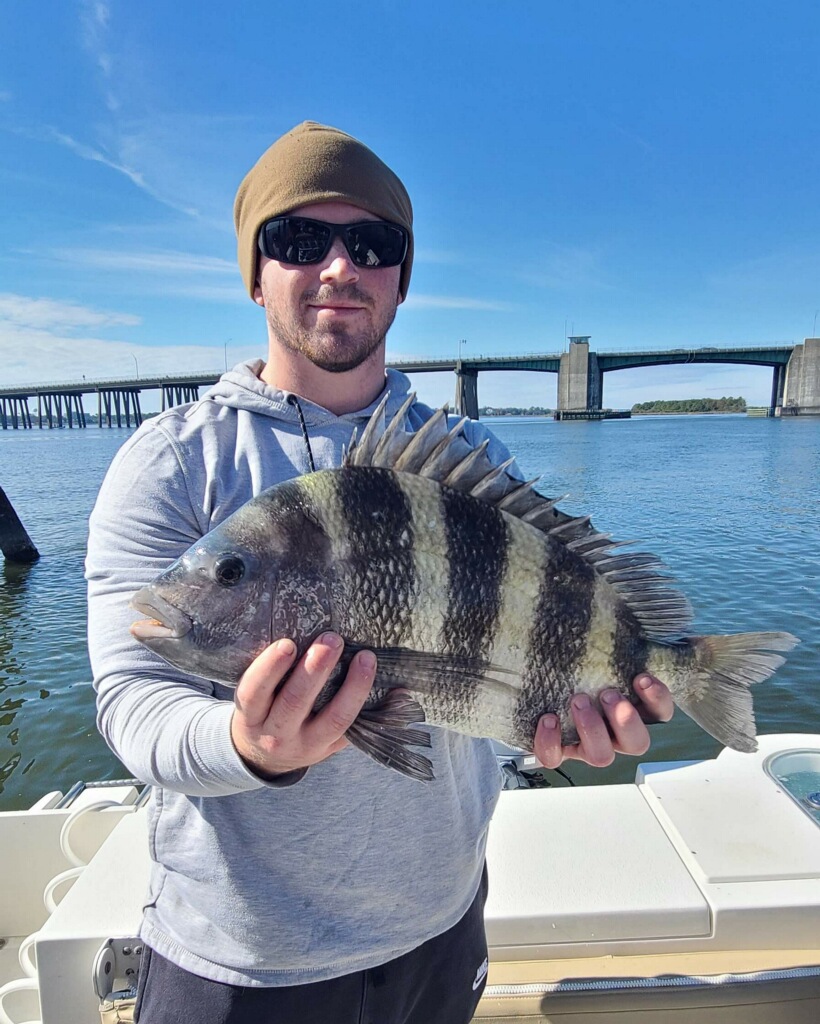 Sheepshead can be challenging to hook, thanks to their stubborn eating habits.
Courtesy Mega-Bite Fishing Charters
Sheepshead can be challenging to hook, thanks to their stubborn eating habits.
Courtesy Mega-Bite Fishing Charters
Capt. Bryan Cuevas from Mega-Bite Fishing Charters in Biloxi, Mississippi spends most of his time chasing redfish and sea trout, but he has noticed growing demand for sheepshead. “People love to eat them before they realize how much fun they are to catch.” Cuevas says sheepshead offer an exciting challenge. “Sheepshead are very picky and hard to fool. They will often will only take live shrimp or fiddler crabs, forget about artificial lures. They don’t hit and run like redfish or trout.” Instead, sheepshead nibble the bait, which forces the angler to stay on their toes.
Cuevas adds another appeal; the little fish pack an explosive fight. Cuevas laughs, “Sheepshead run side to side and up and down trying to break the line in the structure.” He’s seen a client break off a sheepshead, re-rig and hook the same fish. Cuevas marvels, “The sheepshead still had the first hook in its mouth.” A decade ago, sheepshead were ignored by guides and light tackle anglers. Cuevas says a change in attitude followed the BP oil spill. “People couldn’t catch snapper but they discovered sheepshead taste just as good.” Since then, he’s seen the popularity grow as people target the fish with light tackle over shallow structure. But, Cuevas admits some anglers consider sheepshead too ugly to eat, “I’ve had people tell me sheepshead don’t look appetizing.”
Bluefish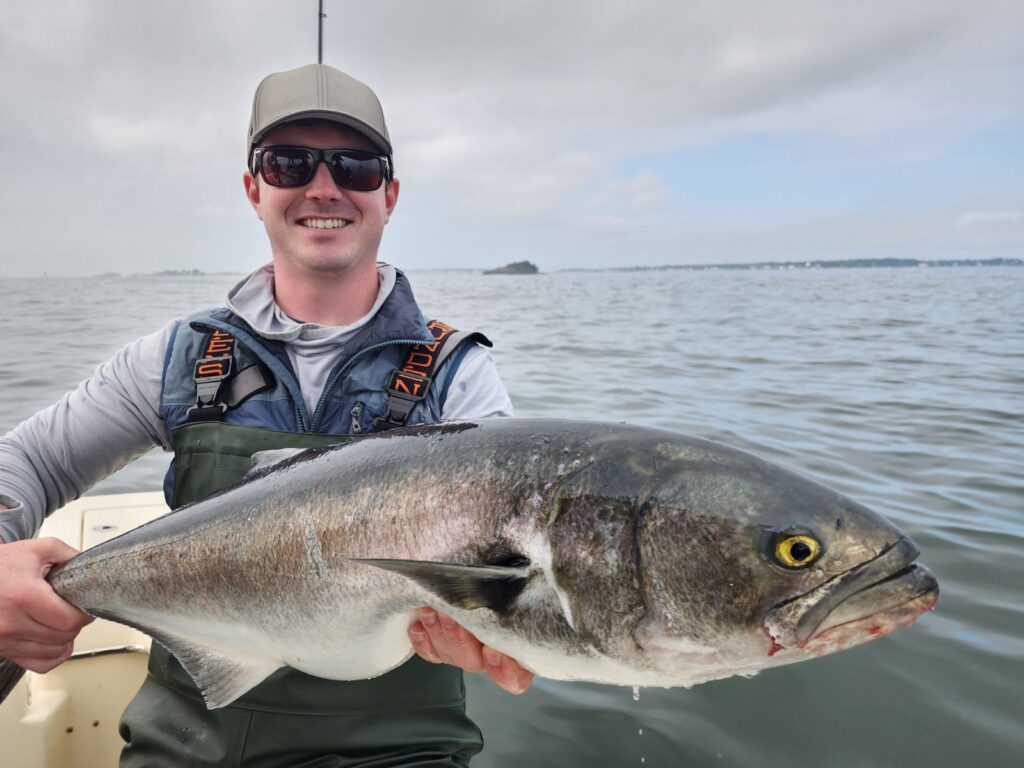 Bluefish are vicious predators, often prowling in large packs.
Courtesy Get Tight Sportfishing
Bluefish are vicious predators, often prowling in large packs.
Courtesy Get Tight Sportfishing
“I love bluefish more than striped bass,” Capt. Brian Coombs of Get Tight Sport Fishing happily admits. Famous for their voracious appetite and nasty attitude, big bluefish are called choppers. A head like a cinder block, a long, thick body of muscle and a mouth full of sharp teeth don’t help the bluefish’s bad reputation. But considering striped bass are one of the most popular sportfish in Coombs’ native Boston Massachusetts, favoring much maligned bluefish is a scandalous confession. Coombs backs up his opinion, “They fight harder than a bass, smashing a topwater, jumping and thrashing.”
Coombs comes to his appreciation honestly. “When I was a kid, striped bass were scarce but big bluefish were everywhere.” His first encounters with trophy fish on lures came at the jaws of big blues. Over the past decade, striped bass rebounded and anglers turned away from big blues. Still, Coombs still carries a torch for bluefish. “When I find bluefish, I usually find a lot of them.” His best days produce dozens of big blues up to 15 pounds on topwater lures and medium-weight tackle. Coombs understands why some anglers ignore the bluefish bonanza. “People say bluefish don’t taste good, but that depends on the size of the fish and where I catch it.” Coombs says fish feeding on squid taste better than blues that have been gorging on menhaden and mackerel. And, smaller fish under 10 pounds aren’t as oily as bigger blues. The bluefish’s great appeal is the fight. “On light tackle with a topwater lure, you can’t beat the fight,” Coombs says. While striped bass numbers are always fluctuating, Coombs says bluefish action has been strong in recent years. “I couldn’t be happier,” he laughs.
The post Five Underrated Fish appeared first on Salt Water Sportsman.
- Home
- About Us
- Write For Us / Submit Content
- Advertising And Affiliates
- Feeds And Syndication
- Contact Us
- Login
- Privacy
All Rights Reserved. Copyright , Central Coast Communications, Inc.